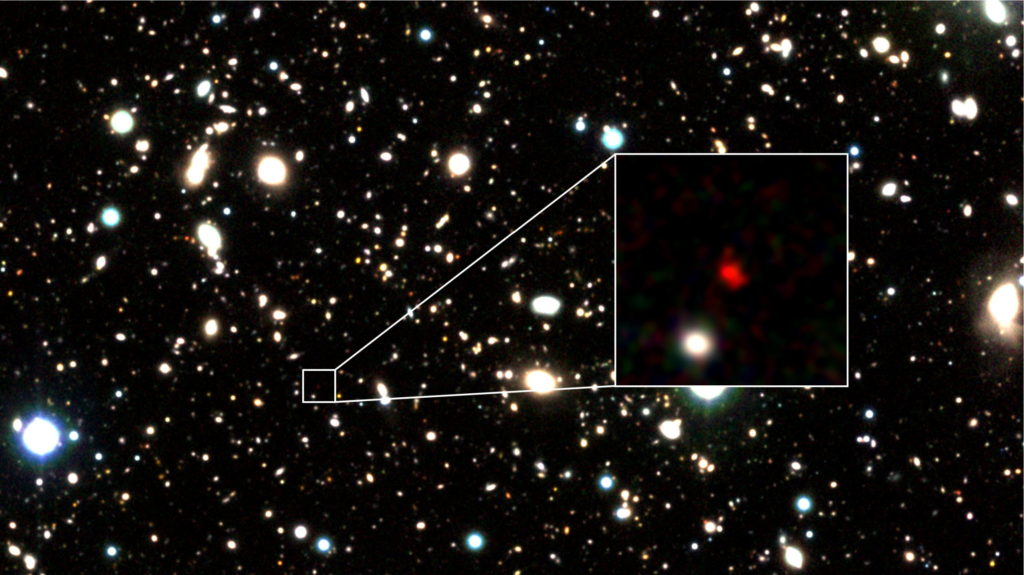Astronomers have achieved a remarkable feat: they have detected the magnetic field of a galaxy that is more than 11 billion light-years away from Earth. The galaxy, known as 9io9, offers a glimpse into the universe when it was just 2.5 billion years old, or about 20% of its current age. This is the most distant detection of a galaxy’s magnetic field to date, and it reveals new insights into how galaxies evolve and form stars.
How did they find new galaxy
The astronomers used the Atacama Large Millimeter/submillimeter Array (ALMA), a powerful radio telescope located in the Chilean desert. ALMA can observe the faint signals emitted by dust and gas in distant galaxies, which are otherwise invisible to optical telescopes. By analyzing the polarization of the light from 9io9, the astronomers were able to measure the orientation and strength of its magnetic field. Polarization is a property of light that describes the direction in which the electric field oscillates. Magnetic fields can affect the polarization of light by rotating or aligning it in a certain way.

The astronomers detected a partial arc of polarized light around 9io9, which indicates the presence of a large-scale magnetic field that spans over 16,000 light-years across the galaxy. The magnetic field is about 1,000 times weaker than Earth’s, but it is similar to those observed in nearby galaxies. This suggests that galactic magnetic fields are a common feature of the universe, even in its early stages.
Also read : The Great Cosmic Void: What Keeps Space Empty?
Why does it matter?

Galactic magnetic fields are important for understanding how galaxies form and evolve over time. Magnetic fields can influence the dynamics of gas and dust in galaxies, which are the raw materials for star formation. Magnetic fields can also affect the radiation emitted by stars and other sources, such as supernovae and black holes, which can heat up or ionize the surrounding gas. Magnetic fields can also help shape the structure and morphology of galaxies, by creating spiral arms or jets.
However, the origin and evolution of galactic magnetic fields are still poorly understood. Astronomers do not know how magnetic fields are generated in the first place, or how they are amplified and maintained over cosmic time. By observing magnetic fields in distant galaxies, astronomers can test different theories and models of galactic magnetism, and compare them with the observations of nearby galaxies. This can help them unravel the history and physics of the cosmic evolution.
What’s next?
The detection of 9io9’s magnetic field is a remarkable achievement, but it is only the tip of the iceberg. The astronomers plan to use ALMA to observe more distant galaxies and measure their magnetic fields. They also hope to combine ALMA with other telescopes, such as the upcoming James Webb Space Telescope, to obtain more detailed information about the properties and environments of these ancient galaxies. By doing so, they hope to shed more light on the mysterious and fascinating phenomenon of galactic magnetism.
FAQ
1: How far away is the galaxy with the detected magnetic field? A1: The galaxy with the detected magnetic field is an astonishing 11 billion light-years away, providing a glimpse into the early stages of the universe.
Q2: How did scientists detect the magnetic field from such a distant galaxy? A2: Scientists used advanced astronomical instruments and cutting-edge technology to capture the faint signatures of the galaxy’s magnetic field. These instruments allowed them to observe light that has traveled for 11 billion years.
Q3: Why is the discovery of a galaxy’s magnetic field significant? A3: The discovery is significant because it provides insights into the magnetic forces shaping galaxies across vast cosmic distances. Magnetic fields play a crucial role in the formation and evolution of celestial bodies.
Q4: What does the detection of a magnetic field in a distant galaxy reveal about the early universe? A4: The detection offers a glimpse into the conditions of the early universe, providing information about the magnetic environment that influenced cosmic structures during their formative years.
Q5: How does understanding magnetic fields contribute to our knowledge of galactic evolution? A5: Studying magnetic fields helps scientists understand the history, composition, and behavior of galaxies. It is a fundamental aspect of galactic evolution, influencing the formation of stars and other cosmic phenomena.
Q6: What are the implications for future astronomical explorations? A6: The discovery opens the door for future explorations into the magnetic nature of distant galaxies. As technology advances, astronomers anticipate uncovering more about the role of magnetic forces in the cosmos.
Q7: Are there unanswered questions about cosmic magnetism? A7: Yes, the discovery raises new questions about cosmic magnetism, inspiring further exploration. Scientists aim to delve deeper into the magnetic forces that govern the universe, uncovering more about its intricate workings.
Q8: How does this discovery contribute to our broader understanding of the cosmos? A8: The discovery contributes to our broader understanding by highlighting the pervasive nature of cosmic magnetism. It underscores the interconnectedness of magnetic forces with the evolution of galaxies, enriching our comprehension of the cosmic symphony.
Also read : Farewell To The Rings: Saturn’s Stunning Feature To Vanish From View In March 2025, NASA Announces




































